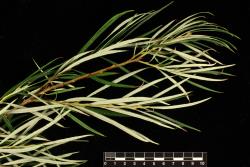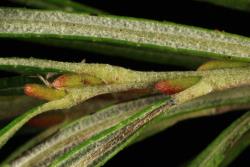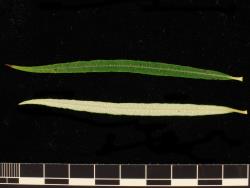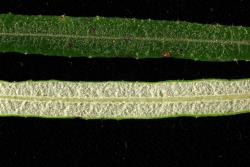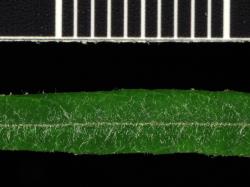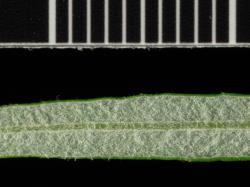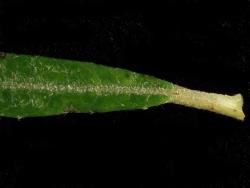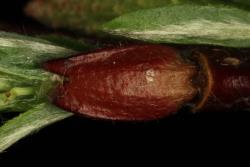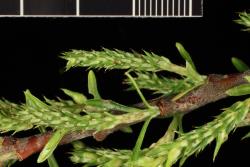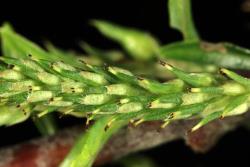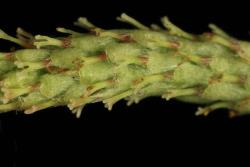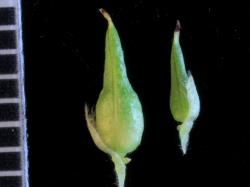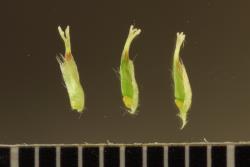Tall shrubs 8–10 m tall. Current year's branchlets moderately densely tomentose, rubbed off in places. Year-old branchlets greyish red-brown (UCL46), glabrous or with sparse, cobwebby hairs persisting. Flower bud scales 6 mm long, 2 mm wide, with 2 angles, moderate to dark red-brown (UCL43–44), hairs sparse. Leaf buds hairy, moderately densely tomentose. Leaves alternate. Stipule not persisting, 0.1 mm long, a tiny, black dot. Petiole 2.4–4.0 mm long, with cobwebby hairs, groove absent, glands absent, base not enlarged. Emerging leaves green, densely tomentose. Proximal leaves toothed but teeth concealed by rolled margin. Leaf lamina 67–82 mm long, (2.6)3.0–4.5 mm wide, length to width ratio 17.7–26.4:1, linear, not falcate; base cuneate; apex very narrowly acute; leaf galls absent; margins entire, strongly revolute, with marginal or intramarginal glands; upper lamina surface slightly bullate due to impressed veins, slightly glossy, sparsely tomentose, tomentum dense on midvein, stomata absent; lower lamina surface densely and persistently tomentose. Catkins opening simultaneously with leaves. Flowering branch 27–35 mm long with 4 subtending leaves. Female catkin 16–30 mm long, 5 mm diameter; catkin rachis not visible between flowers. Flower bract 1.8–2.2 mm long, 0.6–1.0 mm wide, hyaline yellow-green, channelled and curved; apex obtuse, sometimes appearing bitten, sparsely short-silky hairy on both surfaces and margins, or inner surface and margins, persisting. Female nectary 1, 0.5 mm long, 0.4 mm wide, yellow; ovary 2.4–3.0 mm long, glabrous; stipe 0.1 mm long, style base 0.6–0.8 mm long, style arms 0.6–0.8 mm long, unlobed or lobed to a depth of 0.1–0.3 mm; ovary and style extending beyond the flower bract.
A tall shrub (to 8–10 m) with very narrow leaves (2.6–4.5 mm wide) that have strongly recurved margins. The leaf underside is densely and persistently tomentose, the upper surface is sparsely tomentose, the hairs not persisting. Young branchlets are densely tomentose. As in the UK (Meikle 1984), only female plants are present in New Zealand. The flower bracts are pale green and the apex obtuse or 'bitten'; i.e. unevenly toothed, with sparse hairs extending beyond the apex. Ovaries are glabrous and subsessile, the style is long, and the style arms are long and sometimes divided.
No other willow in New Zealand has such narrow leaves. Salix viminalis approaches S. eleagnos in having very narrow leaves but has appressed long-silky hairs on the lower leaf surface, while S. eleagnos has woolly tomentum.
Gisborne (Ōpōtiki 1975), Volcanic Plateau (Rangitaiki River 1953), Southern North Island (Lake Wairarapa 2011), Marlborough (Wairau River 1950, Waima River 2015), Westland (Lake Moeraki 1970, Perth River 2004, Poerua River 1980) Canterbury (Kaikōura 1997, Oaro 1996, Lottery River 1973, Waimakariri River south bank near S.H.1 1991, Rakaia River 1962, 2013, Waihi River 1964). It has commonly been cultivated.
First collection: CHR 74595, Orchard Instructor Blenheim sent to V. D. Zotov, 27 September 1950, Wairau River. The specimen label does not specifically state that the plant was wild.
First publication: Healy 1968.
Flowering: Mid-September–November.
Diploid, 2n = 38 (CCDB based on 13 counts), provisionally confirmed using flow cytometry with PN225.
The original spelling was "eleagnos", an acceptable Greek form. The spelling "elaeagnos" is incorrect.



